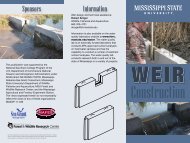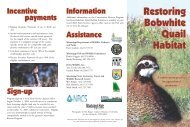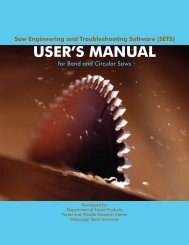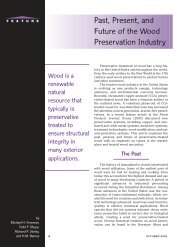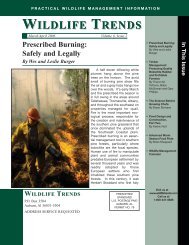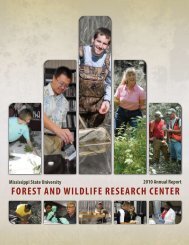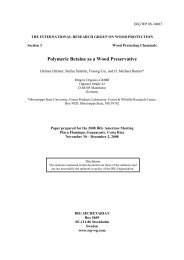Mid-contract Management Opportunities on Conservation Reserve ...
Mid-contract Management Opportunities on Conservation Reserve ...
Mid-contract Management Opportunities on Conservation Reserve ...
You also want an ePaper? Increase the reach of your titles
YUMPU automatically turns print PDFs into web optimized ePapers that Google loves.
Wildlife Trends - Practical Wildlife <str<strong>on</strong>g>Management</str<strong>on</strong>g> Informati<strong>on</strong><br />
Prescribed burning <strong>on</strong> grass CRP fields reduces litter,<br />
creates bare ground, and stimulates diverse community<br />
of native grasses, forbs, and legumes.<br />
si<strong>on</strong>al species. However, in some locati<strong>on</strong>s,<br />
seed banks can be impoverished or dominated<br />
by undesirable agricultural weed species due<br />
to a history of intensive row cropping. In these<br />
circumstances, interseeding of legumes,<br />
including partridge pea, clover, or lespedeza,<br />
can substantially enhance habitat quality.<br />
Interseeding of legumes is an approved mid<str<strong>on</strong>g>c<strong>on</strong>tract</str<strong>on</strong>g><br />
management practice <strong>on</strong> most<br />
C<strong>on</strong>servati<strong>on</strong> Practices in about 3/4 of southeastern<br />
states.<br />
Light disking or strip-disking is an approved<br />
mid-<str<strong>on</strong>g>c<strong>on</strong>tract</str<strong>on</strong>g> management practice <strong>on</strong> CP1,<br />
CP2, CP4, and CP10 in most southeastern<br />
states. The specific manner, extent, and intensity<br />
permitted vary am<strong>on</strong>g states. However,<br />
across all states, the disking must be accomplished<br />
in such a manner as to not compromise<br />
the erosi<strong>on</strong> c<strong>on</strong>trolling objectives of CRP.<br />
Rotati<strong>on</strong>al strip-disking <strong>on</strong> the c<strong>on</strong>tour is an<br />
effective way to accomplish disking without creating<br />
an erosi<strong>on</strong> problem. The NRCS-WHMI has<br />
developed a publicati<strong>on</strong> describing rotati<strong>on</strong>al<br />
strip-disking. You can access this document at<br />
http://www.whmi.nrcs.usda.gov/technical/fieldb<br />
order.html. Look for the publicati<strong>on</strong> entitled<br />
“Light Disking to Enhance Early Successi<strong>on</strong>al<br />
Wildlife Habitat in Grasslands and Oldfields:<br />
Wildlife Benefits and Erosi<strong>on</strong> Potential”.<br />
In most Southeastern states, prescribed<br />
fire is an approved mid-<str<strong>on</strong>g>c<strong>on</strong>tract</str<strong>on</strong>g> management<br />
12<br />
practice <strong>on</strong> both grass (CP1, CP2, CP4, CP10)<br />
and pine (CP11 and CP3 l<strong>on</strong>gleaf) c<strong>on</strong>servati<strong>on</strong><br />
practices. Prescribed fire should be applied in<br />
a rotati<strong>on</strong>al fashi<strong>on</strong>, burning <strong>on</strong> a 2 or 3-year<br />
rotati<strong>on</strong>. A 3-year rotati<strong>on</strong> can be accomplished<br />
with whole field treatments, or partial<br />
field burns. A whole field rotati<strong>on</strong> would be<br />
accomplished by burning 1/3 of the total number<br />
of your fields each year. Each field would<br />
then be burned every 3rd year. A partial field 3yr<br />
rotati<strong>on</strong> would be accomplished by burning<br />
1/3 of each field, each year. This can be d<strong>on</strong>e<br />
in strip or block fashi<strong>on</strong>. Individual burns<br />
should be 3 - 30 acres. Larger fields (> 30<br />
acres) should be subdivided and burned in a<br />
partial field prescripti<strong>on</strong>.<br />
<str<strong>on</strong>g>Mid</str<strong>on</strong>g>-<str<strong>on</strong>g>c<strong>on</strong>tract</str<strong>on</strong>g> management guidelines for<br />
prescribed fire vary am<strong>on</strong>g states. Be sure to<br />
c<strong>on</strong>tact your local USDA Service Center to determine<br />
approved practices in your state. In all<br />
states, prescribed burns must be c<strong>on</strong>ducted in<br />
accordance with NRCS practice standards and<br />
state-specific prescribed fire laws to qualify for<br />
cost-share. Although these standards and laws<br />
differ am<strong>on</strong>g states, in general, landowners<br />
wanting to prescribe burn should do the following<br />
things first: 1) develop a written, notarized<br />
fire prescripti<strong>on</strong> that details ownership,<br />
acreage, locati<strong>on</strong>, fuel type, purpose of burn,<br />
igniti<strong>on</strong> method, weather parameters under<br />
which the burn will be c<strong>on</strong>ducted, c<strong>on</strong>trol and<br />
suppressi<strong>on</strong> methods available <strong>on</strong> site the day<br />
of the fire, smoke management screening, and<br />
c<strong>on</strong>tact informati<strong>on</strong> for individual resp<strong>on</strong>sible<br />
for the fire; 2) secure a burn permit from your<br />
state Forestry Commissi<strong>on</strong> the day of the fire; 3)<br />
ideally have a certified prescribed burn boss <strong>on</strong><br />
site the day of the fire; 4) execute the burn in a<br />
prudent fashi<strong>on</strong> within the c<strong>on</strong>straints of the<br />
parameters specified <strong>on</strong> your written burn plan.<br />
CRP Pine Plantings<br />
Starting with CRP signup 15, participants<br />
that wanted to re-enroll CP3 pine tree plantings<br />
(as CP11) had the opportunity to increase their<br />
chance of having their bid accepted by<br />
increasing the Envir<strong>on</strong>mental Benefits Index<br />
(EBI) of their offer in two ways. Prospective<br />
program participants could agree to thin the<br />
pine planting within the first 3 years of the sec-<br />
November/December 2005



